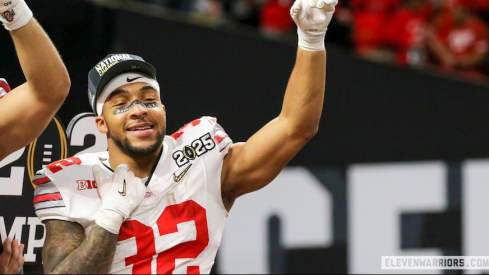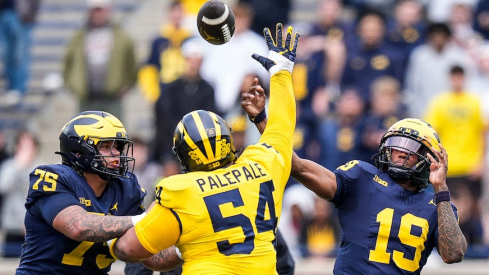
With spring practice complete, it is time to turn back to outlining Urban Meyer's base Ohio State offense.
In my last such post, I examined Meyer's passing game philosophy and began diagramming the base pass plays that Meyer brought with him from Florida. I now want to continue this examination of Meyer's pass plays by looking at the follow-pivot, four verts and "Houston."
Note how in each play the ultimate goal is to use route combinations to create an area where the offense has two receivers against one defender. In so doing the offense can make that defender wrong every time. The offense does so either through a vertical stretch where two receivers are at different yard lines with one defender responsible for both, or a horizontal stretch where two receivers are across the field's width.
Follow-Pivot
Follow-pivot is another pass play that has been a staple of Meyer's offense since he and Dan Mullen met with Joe Tiller at Purdue. Follow-pivot builds off follow, a Meyer shallow cross staple. At the snap follow and follow-pivot look alike to the defense, preventing the secondary from pattern reading and jumping shallow cross routes.
With follow-pivot, the inside two receivers both begin running shallow crosses but then pivot out. One outside receiver runs a dig route, while the receiver from the opposite side runs a post.

Coach Hoovler with more on the follow-pivot:
After studying the Follow-Pivot concept, I realized that it was very similar to the NCAA pass (Post-Dig-Drag). However, because of the distribution of routes, this concept is better suited to beat Quarters coverage.[...]
Conceptually, the play creates a High-Low on the Free Safety, as well as [a] Middle-Triangle [read] off the two weak-side Linebackers (or weak-side and middle LBs). I always put the Post to the boundary, and have the Follow route coming from the field. I do this because teams will almost always rotate their coverage to the field (which would disrupt my Triangle) or because we see a lot of Quarters with the Strong Safety inside my #2 receiver to the field (which makes it difficult for that receiver to run the Post). I must create a situation where I can isolate the Free Safety for my High-Low read, and my Post and Follow routes can win.
The two receivers closest to the ball will run Pivot routes if displaced or Check-down/Breakout routes from the backfield. Their purpose is to attract the two LBs closest to the Post, or replace those LBs if they disappear in coverage or become pass rushers. Those two LBs are also the players that we are trying to occupy get the Follow route open.
In short, the goal is to create a 2-on-1 vertical stretch with the post dig versus the free safety.
Three points worth making. As noted, the play is designed to beat quarters coverage. Meyer's offense often faces cover 4, as it allows a defense against the spread to account for the quarterback in the run game and yet defend four immediate vertical threats.
Second, the play creates a triangle stretch on the defense. Though an offense can make an educated guess at what coverage a defense will run, it can never know. A triangle stretch provides a vertical and horizontal read that allows the offense to have an answer for different coverages. The play has a horizontal stretch with the pivot routes.
Third, it yet another example that Meyer likes getting the ball to his inside receivers to let them make plays in space.
Four Verticals
Four verticals or "four verts" is perhaps the most popular play in football. As the concept implies, four receivers run go routes. By splitting the field into quarters, typical two or three deep zone defenses cannot defend the route.
As Chris Brown notes:
Although when you talk about a "vertical" or "streak route," most people think of a deep bomb down the sidelines, the four-verticals concept really attacks the safeties; the outside routes will be thrown at times based on matchup, but usually you're trying to make the free safety wrong.
Above the the typical route setup. It carries some dynamic aspects, most usually the use of a "bender" receiver -- an inside receiver who will "bend" to a post route when the middle of the field is "open" (i.e. two deep safeties on the hashes, rather than a single one down the middle), and will stay on his seam route up the hashmark when there is a deep middle safety, as with Cover Three. Most college and even pro teams run it this way; it's a good play. I've discussed this "bender" or "divide" route in more depth previously.
The upshot is that the throw is generally thrown into a tight window between deep defenders.
A defense's best method to defend the play is either man coverage or cover 4. Offenses will therefore try to dictate a defense into single high coverage by running the play from trips. Defenses do not like playing split coverage against trips because the offense gains a numerical advantage to the trips side. The offense will then have the inside receiver bend back across the field, creating a 2-on-1 horizontal stretch upon the deep safety.
Houston
Houston simply signifies a traditional curl-flat combination combined with a seam or divide route. Again, from Coach Hoover:
The outside receiver to the field runs at 12-yard Curl. The number two receiver to the field runs what we call a “Bender.” He bursts up the hash (slight outside release) and reads the area in front of him. If there is no safety or he feels that he can run by the safety, he will do so. If the safety plays deep over the top of our guy, he will “bend” inside at 12 yards at a controlled speed. The number three receiver runs a Flat route and wants to expand quickly, throttle once he gets outside of the widest receiver, and finally sit out on the numbers if the ball is still in the QBs hand. The backside receiver can run an automatic route, or we can tag him. The default route we want on the backside is a 7-step Speed-Post.
This is another Meyer route combination designed to beat cover 4. The divide route occupies the safety, allowing the curl route to work inside against a corner who will be playing with outside leverage. The curl and flat then have a two on one hi-lo stretch against the outside linebacker.

This largely completes my review of base pass plays Meyer brought with him from Florida. Next week I will examine those plays that have become a staple of his offense as a result of his collaboration with Tom Herman.

